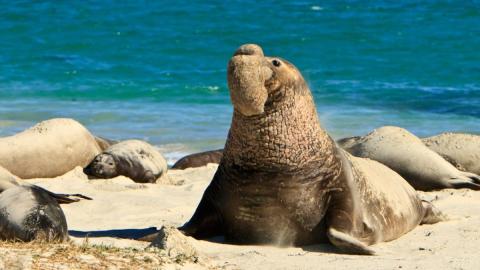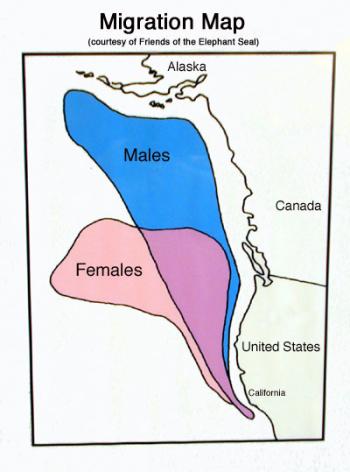
These huge seals are superb hunters and athletes in the sea — on land, not so much.
Elephant seals come ashore to breed and give birth in the winter and to molt, shedding their fur and top layer of skin. When not doing this, they’re out to sea traveling in search of food. This video from KQED’s Quest gives a good overview of their natural history.
Elephant seals spend 80 percent of their lives in the open sea, from Mexico to Alaska, in search of food. 90 percent of that time is spent underwater: eating, digesting, resting briefly, and traveling. When they forage during their migrations, they don’t sleep. They cat nap.
“The northern elephant seal males range across the Pacific Ocean almost half way to Japan. They tend to stay more northerly than the females. The female northern elephant seals range out to sea off the west coast of the US, but only out as far as the center of Alaska.”
As the map shows, when the seals leave the breeding grounds, males and females head out separately to feed. They

complete two annual, very long, round-trips: females journey over 11,000 miles, while males travel 13,000 miles.
Elephant seals are active predators, diving almost continuously to depths of 1,000 to 2,000 feet. Lasting close to half an hour, the dives are followed by only three to five minutes at the surface to breathe.
These are long, breath-hold dives in a cold, dark, ocean: How do the seals survive these extreme dives to hunt at depths in the dark? They are superbly adapted in the following ways:
•thick blubber keeps them warm
•regulating their internal thermostat
•conserving their bodies’ oxygen while diving by compressing their lungs before diving so there’s little air left to be compressed at depth
•carrying all the oxygen they need in their blood rather than their lungs
• compressing their fat so they lose buoyancy and sink and so use less energy to get to depth
•more blood and more red blood cells carrying hemoglobin: 20% of their body weight is blood (ours is only 6%)
•store oxygen in their muscle
•reducing their heart rate and decreasing blood flow to the extremities, increasing it to brain and vital organs. Their heart rate is 55–120 beats per minute, but when they dive, the heart slows to 4–15 beats per minute.
Elephant seals dive repeatedly to feed for four to five months during summer and fall. Scientists have looked at their dive profiles, and it’s as though the seals are making long, vertical commutes. With big eyes and keen vision (and adaptions listed above) they can hunt successfully at depths. This ability to hunt at extremes means that elephant seals can leave behind both competitors and predators in shallower waters. Their prey have the same strategy: when light levels are high, fish and squid remain in the depths to avoid predators. Some examples of elephant seal prey are: squid, rockfish and hake that live in the deep waters off the continental shelf
Watch to see what it’s like to be up close to these huge animals on the beach.
More information about elephant seals















